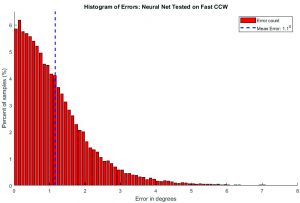Position Estimation of Outer Rotor PMSM Using Hall-Effect Sensors and Neural Networks
MS student Yuyao Wang with advisor K. Haran
Driving and controlling a permanent magnet synchronous machine requires precise knowledge of the rotor’s angular position, such that the voltages and currents can be applied with the right phase difference to extract maximum torque and efficiency from the machine. Conventional sensored methods required attachment of a position transducer directly onto the rotor, increasing cost and complexity. Sensorless methods rely on either injecting a high-frequency signal or measuring the back-emf from the rotor and do not perform well at low speeds.
This project explores an alternative method of using an array of simple Hall-effect sensors, positioned to measure the leakage magnetic field from the rotor. These measurements are used to train a neural network to extract the rotor angle from the data. Selecting a neural network offers the advantage of robustness to multiple sensor failures without requiring the transfer function to convert from measured data to rotor angle. Initial results achieved a mean error of 1.1 electrical degrees, with 90% of the errors less than 2.5 electrical degrees. Figure 5 shows the error distribution between the neural-network predicted angle and the actual angle. This research is supported by the Grainger Center for Electric Machinery and Electromechanics.
